Replica Cryptia: Okapis
Posted by: Loren Coleman on September 15th, 2009
[First published November 16, 2007; updated September 15, 2009.]
The story of the okapi (Okapia johnstoni), from its 1900-1901 discovery to the June 9, 2006 announcement of its rediscovery in the Congo’s Virunga National Park, has made this prehistoric relative of the giraffe one of the first “darlings of cryptozoology.”
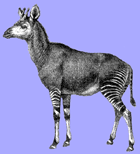
The International Society of Cryptozoology used an okapi as their logo (above), as have others (below).
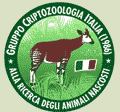
The first illustrations that were published upon their discovery, show the okapis as truly dynamic animals (below).
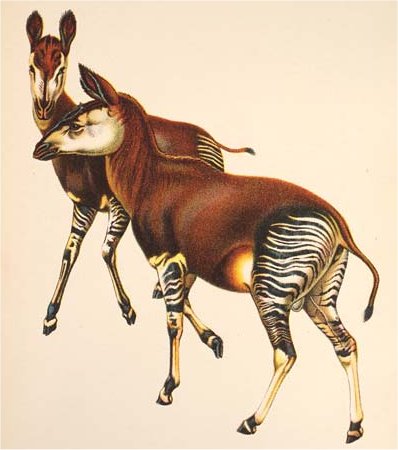
Old drawings then took on a static look. Some made the link between the giraffe and okapi (below), as in this early turn of the 20th century drawing, in which the text noted that the okapi “gives a good idea of what the giraffe’s ancestors were like.”
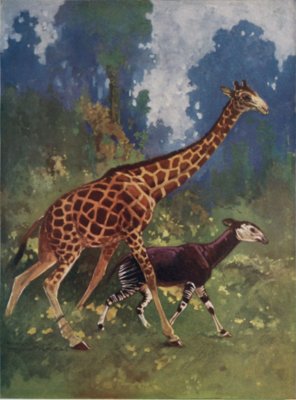
As to replicas, both companies, Safari and Schleich, do good jobs with their models.
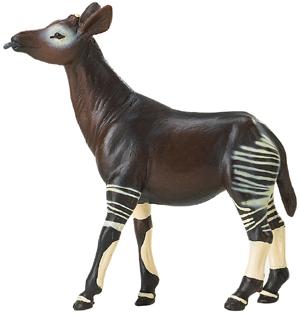
The Safari Okapi (above).
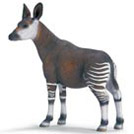
Two views of the Schleich Okapi (above and below).
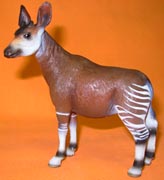
The following replica okapi is made by an unknown company but probably is Playvision or AAA from China. The search goes on to discovery one for the museum collection. Let me know if you find one.
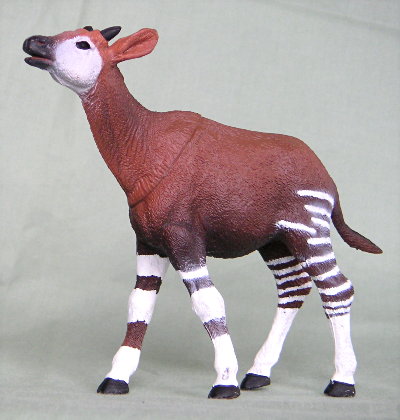
++++
Support the new, openly public, physical location of the International Cryptozoology Museum in downtown Portland, Maine. Help us meet the rent and other new expenses for this great adventure.
Please click on the button below (not the one up top) to take you to PayPal to send in your donation.
If you wish to send in your donation via the mails, by way of an international money order or, for the USA, via a check or money order, please use this snail mail address:
Loren Coleman
International Cryptozoology Museum
PO Box 360
Portland, ME 04112
Thank you, and come visit the museum at 661 Congress Street, Portland, Maine 04101, beginning November 1, 2009!!
About Loren Coleman
Loren Coleman is one of the world’s leading cryptozoologists, some say “the” leading living cryptozoologist. Certainly, he is acknowledged as the current living American researcher and writer who has most popularized cryptozoology in the late 20th and early 21st centuries.
Starting his fieldwork and investigations in 1960, after traveling and trekking extensively in pursuit of cryptozoological mysteries, Coleman began writing to share his experiences in 1969. An honorary member of Ivan T. Sanderson’s Society for the Investigation of the Unexplained in the 1970s, Coleman has been bestowed with similar honorary memberships of the North Idaho College Cryptozoology Club in 1983, and in subsequent years, that of the British Columbia Scientific Cryptozoology Club, CryptoSafari International, and other international organizations. He was also a Life Member and Benefactor of the International Society of Cryptozoology (now-defunct).
Loren Coleman’s daily blog, as a member of the Cryptomundo Team, served as an ongoing avenue of communication for the ever-growing body of cryptozoo news from 2005 through 2013. He returned as an infrequent contributor beginning Halloween week of 2015.
Coleman is the founder in 2003, and current director of the International Cryptozoology Museum in Portland, Maine.

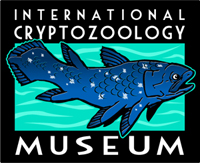









This is a very cool series of blogs.
Agreed. I’m wishing I still had my old plastic dinos now. I do have an inflatable pterodactyl, though…
Seriously, though, this stuff is neat, Loren. Thanks.
Keep it up, I love these articles.
I’d imagine there are a ton of cryptozoological animals in replica form. Like the Thylacine, Architeuthus, coelacanth, Saola, moa, etc. I’m trying to find a Laotion Rock Rat…
Maybe, to go out on a limb, cougars and grizzely bears if in the context of Colorado or the eastern US? (I suppose one could also get a chimp replica and put it in the context of the Bili Ape, but again, definetly out on a limb).
Actually, there are less than you can imagine. I have yet to see one of a coelacanth (that is until 2009) or saola.
One or a few at a time, so I’ll stay on-target and on-topic with the okapis.
Darren Naish has backchanneled me, saying he thinks the unknown okapi replica appears to be from the Chinese company AAA, but he’s not certain.
I appreciate the feedback that most people are enjoying where this feature is going.
I really like these articles. I remember in the private school I attended, okapi was the animal they used for “O” in their lesson plan to help teach the kindergarteners their ABC’s.
I’m beginning a craving for these kind of wonderful replicas 😉
That’s very suprising, but you’re totally right.
Surely there is something somewhere, though I have yet to find a thing.
I was just looking at the KAIYODO Deep Sea Coelacanth replica and thinking that it was one of the only plastic Coelacanth that I had ever seen .I would love to have a collection of these things but I have found from experience that things of this type just look like to much fun and my son will quickly have them down from my shelf and into the back yard .
These are fun.
I too got rid of all the toy dinos, and occasionally, like, say, now, wish I hadn’t.
One of the above models (the Safari model) seems to show a facial coloration I am not familiar with. (The others show the white face, not the white “eye patch.”)
Cool replicas indeed.
The Okapi has been filmed in the wild I think the last film was National Geographic or BBC, broadcast in 2007. The models don’t seem to do it justice making it look rather chunky but films of it suggest it is a slender and elegant animal. I prefer this view of course, which adds a lot to its charm and strengthens the image of it slipping silently and mysteriously away through the forest.
Of course I am open to correction on this as I have never seen the animal in the flesh, so far, in one of the number of zoos who keep them.
What a talent it has to housekeep its long ears, and eyes, with its even longer blue tongue.
Norman-uk says the replicas look “chunky” versus the okapis he’s seen on television.
I have seen these animals in zoological parks, from the okapis at the St. Louis Zoo that I saw there in the 1950s to the ones observed at the San Antonio Zoo a couple years ago.
Like all animals, they come in a variety of shapes and sizes, with those captives often being heavier. But I don’t see the “chunkiness” you see, norman-uk, in the replicas. They actually look rather on-target for what we know of these animals from the wild.
Greetings All!
The St. Louis Zoo still has okapi in its exhibits. It is one of the two greatest free zoos in the country, and I recommend a visit! Plus lots of crypto-related places to check out nearby! (I’d skip the feral dogs who starred in the Monsterquest episode “The Real Cujo.”) But the Piasa Bird and Momo are yet to be documented on film!
Ah, yes, fossilhunter, the St. Louis Zoo was also one of the first zoological parks in the USA (and the world) to have exhibited another “darling of cryptozoology” ~ the Komodo dragon in the 1930s.